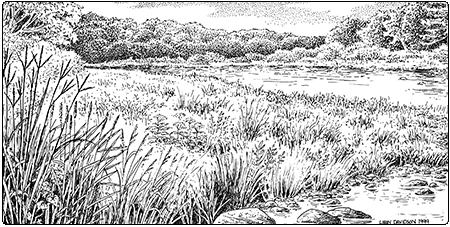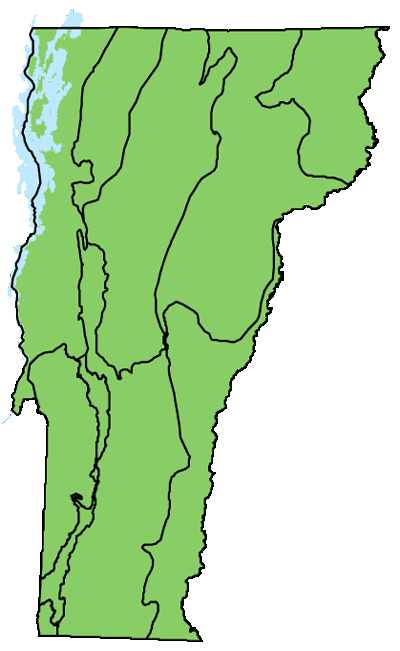Ecology and Physical Setting 
The lush growth of tall grasses and summer-flowering herbs adds a belt of color along many rivers. Rivershore Grasslands are open wetland communities on relatively stable substrates along high-energy stretches of our larger rivers. Rivershore Grasslands typically occur in the zone that includes the upper portion of the active river channel. Rivershore Grasslands commonly grade into River Cobble Shore, River Sand or Gravel Shore, or River Mud Shore communities closer to the river. On the uphill side, there can be a gradual rise to a floodplain community, or a sharp rise to a level floodplain or upland community. Rivershore Grasslands are more common on the inside of river meanders, where there is less erosion and more deposition of alluvial silt and sand. On higher gradient river segments the substrate is primarily cobble and gravel, and the alluvium accumulates in the interstitial spaces. Organic matter also accumulates here.
 Rivershore Grasslands are maintained as open communities by high river flows in spring and summer. Ice scouring during winter and early spring also restricts the establishment of woody plants in this community. Over a period of many years, as the river channel continues to migrate laterally and as alluvium is deposited, Rivershore Grasslands move as well. Rivers are dynamic—a single large storm can change the channel location and reorganize rivershore communities.
Rivershore Grasslands are maintained as open communities by high river flows in spring and summer. Ice scouring during winter and early spring also restricts the establishment of woody plants in this community. Over a period of many years, as the river channel continues to migrate laterally and as alluvium is deposited, Rivershore Grasslands move as well. Rivers are dynamic—a single large storm can change the channel location and reorganize rivershore communities.
Vegetation
Tall grasses and herbs dominate Rivershore Grasslands. Woody plants typically do not survive on the lower, wetter portions of the grassland but may be scattered on the upper margins where flooding and ice scouring are less severe. The organic-rich interstices between cobbles are commonly vegetated by bryophytes. Overall, Rivershore Grasslands are more than 50 percent vegetated, but the distribution of species and the abundance of plants may vary with distance from the river.
Common species in Rivershore Grasslands are big bluestem, bluejoint grass, woolly panic grass, Indian hemp, and Joe-pye weed. Occasional shrubs and vines include speckled alder, bush-honeysuckle, and riverbank grape. Non-native species, including reed canary grass and Japanese knotweed, can be abundant.
Wildlife Habitat
Green frogs and northern leopard frogs may be found in these densely vegetated shores. Mink move stealthily through these shorelines in search of frogs, small mammals, and insects. The uncommon water shrew favors grassy, sedgy, or shrubby areas along cool-water streams, and may be found in Rivershore Grasslands, especially in the cooler regions of Vermont. Meadow voles may be common. A macropis bee, Macropis nuda, specializes on the floral oils and pollen of the plant genus Lysimachia; fringed loosestrife (Lysimachia ciliata) is a common plant found in Rivershore Grasslands. The larvae of the rare dusted skipper butterfly are dependent on little bluestem and big bluestem, two grasses that can be abundant in Rivershore Grasslands.
Related Communities
- River Sand or Gravel Shore is a sparsely vegetated community on moderate-energy sites along rivers. It may grade into the more densely vegetated Rivershore Grassland community.
- River Cobble Shore is a sparsely vegetated community found at high-energy locations. It may also grade into the more densely vegetated Rivershore Grassland community.
- Lakeshore Grassland occurs along the shores of Lake Champlain and has longer periods of flooding. Wave action and ice rafting are the primary natural disturbances.
Conservation Status and Management Considerations
The ecological integrity of Rivershore Grasslands and other riverside communities is inseparable from the integrity of the rivers themselves. Alteration of flow regimes through dam operation, river channelization, shoreline armoring, and loss of forested riparian areas are all factors that can alter natural river dynamics and, in turn, affect shoreline and floodplain communities. Like all rivershore communities with exposed mineral soils, Rivershore Grasslands are threatened by the spread of non-native, invasive plants.
Distribution/Abundance 
Occurs throughout Vermont, but large, well-developed examples are restricted to the Connecticut, West, White, and Winooski Rivers. Similar communities are described for all of eastern North America.
Characteristic Plants
Shrubs and Vines
Occasional Species
Speckled alder – Alnus incana
Bush-honeysuckle – Diervilla lonicera
Riverbank grape – Vitis riparia
Meadowsweet – Spiraea alba
Purple-flowering raspberry – Rubus odoratus
Herbs
Abundant Species
Bluejoint grass – Calamagrostis canadensis
Big bluestem – Andropogon gerardii
Occasional to Locally Abundant Species
Woolly panic grass – Dichanthelium implicatum
Indian hemp – Apocynum cannabinum
Little bluestem – Schizachyrium scoparium
Twisted sedge – Carex torta
Joe-pye weed – Eutrochium maculatum
Common St. John’s-wort – Hypericum perforatum
Groundnut – Apios americana
Cardinal flower – Lobelia cardinalis
Common monkey-flower – Mimulus ringens
Starry false Solomon’s seal – Maianthemum stellatum
Woolly sedge – Carex pellita
Fringed loosestrife – Lysimachia ciliata
Non-Native Invasive Plants
Reed canary grass – Phalaris arundinacea
White sweet clover – Melilotus albus
Purple loosestrife – Lythrum salicaria
Japanese knotweed – Fallopia japonica
Rare and Uncommon Plants

Obedience – Physostegia virginiana
Great St. John’s-wort – Hypericum ascyron
Canada burnet – Sanguisorba canadensis
Wild chives – Allium schoenoprasum
Indian grass – Sorghastrum nutans
Tubercled orchis – Platanthera flava
Associated Animals
Green frog – Lithobates clamitans
Northern leopard frog – Lithobates pipiens
River otter – Lontra canadensis
Mink – Neovison vison
Meadow vole – Microtus pennsylvanicus
Macropis bee – Macropis nuda
Rare and Uncommon Animals
Wood turtle – Glyptemys insculpta
Water shrew – Sorex palustris
Dusted skipper – Atrytonopsis hianna
Places to Visit
Derway Island, Burlington, Winooski Valley Park District
Hartland Rivershore Natural Area, Hartland, The Nature Conservancy
West River, Townshend, U.S. Army Corps of Engineers
West River, Jamaica State Park, Jamaica, Vermont Department of Forests, Parks, and Recreation
